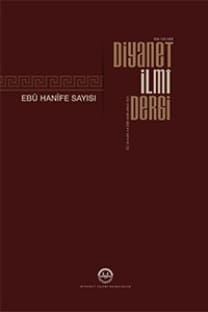İSLÂM VE BATI KÜLTÜRÜ AÇISINDAN KENT, MUAŞERET VE UYGARLIK İLİŞKİLERİ
THE RELATIONSHIP BETWEEN CITY, COEXISTENCE AND CIVILIZATION IN TERMS OF ISLAMIC AND WESTERN CULTURES
Islam, West, City, Etiquette, Civilization,
___
- Aktürk, Şener. “Braudel’den Elias’a ve Huntington’a ‘Medeniyet’ Kavramının Kullanımları”. Doğubatı Düşünce Dergisi 47 (2007), 147-175.
- Aliağaoğlu, Alpaslan ve Uğur, Abdullah. “Osmanlı Şehri”. SDÜ Fen Edebiyat Fakültesi Sosyal Bilimler Dergisi 38 (Haziran 2016), 203-226.
- Auge, Marc. Yok-yerler. İstanbul: Daimon Yayınları, 2017.
- Bilgir, Türkan Merve. “Richard Sennett’in Çalışmalarında Toplumsallaşmanın Bazı Referans Alanları ve Modernlik”. Selçuk Üniversitesi Edebiyat Fakültesi Dergisi 34 (2015), 267–282.
- Can, İslam. “İslam Şehrine Dair Sosyolojik Okumalar”. Opus Uluslararası Toplum Araştırmaları Dergisi 3(2) (2012), 6-27.
- Demirci, Mustafa. “İslam’da Şehir ve Şehrin Sosyal Dinamikleri”, İstem İslam Sanat, Tarih, Edebiyat ve Musıkisi Dergisi 2 (2003), 129-146.
- Demirel, Demokaan. “Fârâbi’nin İdeal Devleti: Erdemli Şehir”. Niğde Üniversitesi İİBF Dergisi 7/1 (2014), 358-369.
- Düzbakar, Ömer. “Osmanlı Döneminde Mahalle ve İşlevleri”. U.Ü. Fen-Edebiyat Fakültesi Sosyal Bilimler Dergisi 5 (2003/2), 97-108.
- Elias, Norbet. Uygarlık Süreci. 1, İstanbul: İletişim, 2004. Ersoy, Ruhi. “Kültür, Siyaset ve Milli Burjuvazi”. Opus Uluslararası Toplum Araştırmaları Dergisi 9/16 (2018), 1549-1565.
- Esenbel, Selçuk. “Türk ve Japon Modernleşmesi: ‘Uygarlık Süreci’ Kavramı Açısından Bir Mukayese”. Toplum ve Bilim 84 (Bahar 2000), 18-35.
- Gezgin, Mehmet Fikret. “Cemaat-Cemiyet Ayırımı ve Ferdinand Tönnies”. Istanbul Journal of Sociological Studies 0(22) (2011), 183-201.
- Guibernau, Montserrat. Nations without States: Political Communities in a Global Age. Polity Press, 1999.
- İbn Haldun. Mukaddime. (2 Cilt), haz, Süleyman Uludağ. İstanbul: Dergâh Yayınları, 2009.
- İnalcık, Halil. “İstanbul: Bir İslam Şehri”. İslâm Tetkikleri Dergisi 9 (0) (1995), 243–268.
- Kıvrım, İsmail. “Osmanlı Mahallesinde Gündelik Hayat: 17. Yüzyılda Gaziantep Örneği”. Gaziantep Üniversitesi Sosyal Bilimler Dergisi 8/1 (2009), 231 – 255.
- Koçyiğit, Tahsin. “Medine’deki Uygulamalarından Hareketle Hz. Peygamber’in Şehir Tasavvuru Hakkında Bazı Değerlendirmeler”. Süleyman Demirel Üniversitesi İlahiyat Fakültesi Dergisi 31 (2003/2), 73–88.
- Kramnic, Isaac. The Portable Burke, Harmondsworth: Penguin, 1999. Meriç, Cemil. Umrandan Uygarlığa. İstanbul: İletişim Yayınları, 2007.
- Michon, Jean Louis. “Dinî Kurumlar”, İslâm Şehri, İstanbul: İz Yayıncılık, 1997.
- Niyazi, Mehmed. İslâm Devlet Felsefesi. İstanbul: Ötüken Neşriyat, 1989.
- Ökmen, Mustafa ve Görmez, Kemal. “İbn-i Haldun Düşüncesinde Kent”. Yerel Yönetimler, Yerel Siyaset ve Kentsel Politikalar. Ed. Bekir Parlak. 481- 506. Bursa: Dora Yayınevi. 2010.
- Öncü, Ayşe. “Elias ve Medeniyetin Öyküsü”. Toplum ve Bilim Sayı 84 (Bahar 2000), 8-16.
- Parlak, Bekir. “Küreselleşme Sürecinde Modern Ulus Devlet ve Kamu Yönetimi”. Çağdaş Kamu Yönetimi-I: Konular Kuramlar Kavramlar. ed. Muhittin Acar, Hüseyin Özgür. 347-391. Ankara: Nobel Yayınları, 2003.
- Savaşır, İskender. Kelimelerin Anayurdu ve Tarihi. İstanbul: Metis Yayınları, 2000.
- Sennett, Richard. Kamusal İnsanın Çöküşü. İstanbul: Ayrıntı Yayınları, 2016.
- Sjoberg, Gideon. “Sanayi Öncesi Kenti”. 20. Yüzyıl Kenti, 37-54. Ankara: İmge Yayınevi, (2002).
- Şahin Musa ve Işık Esra “Osmanlı’dan Cumhuriyete Mahalle Yönetimi”. Dumlupınar Üniversitesi Sosyal Bilimler Dergisi 30 (Ağustos 2011), 221-229.
- Tekin, Üzeyir. “Dünden Bugüne Sosyolojik Açıdan Cemaat ve Cemiyet”. Muhafazakar Düşünce: Cemaatten Cemiyete, Cemiyetten Nereye?, 2, (Güz 2004), 107-119.
- Ferdinand, Tönnies. Cemaat ve Cemiyet. Vakıfbank Kültür Yayınları, 2019.
- Tunç Yaşar, Fatma. “Adab-ı Muaşeret”, Türkiye Diyanet Vakfı İslâm Ansiklopedisi, Ek Cilt 1, 2016.
- Uzut, Mevlüt “Adab-ı Muaşeret Sünnet İlişkisi”. Katre: Uluslararası İnsan Araştırmaları Dergisi: Hadis Özel Sayısı 4 (2017), 147-157.
- Üstel, Füsun. “Makbul Vatandaş”ın Peşinde: II. Meşrutiyet’ten Bugüne Vatandaşlık Eğitimi. İstanbul: İletişim Yayınları, 2008.
- Vural, Tülin ve Yücel, Atilla. “Çağımızın Yeni Kamusal Mekanları olan Alışveriş Merkezlerine Eleştirel Bir Bakış”. itüdergisi/a mimarlık, planlama, tasarım 5/2 (Eylül 2006), 97-106.
- Williams, Raymond. Anahtar Sözcükler; Kültür ve Toplumun Sözvarlığı, Çev. Savaş Kılıç İstanbul: İletişim Yayınları, 2012.
- Yılmaz, Musa Kazım. “Hucurât Suresi’nin Öne Çıkardığı Adab–ı Muaşeret”, Harran Üniversitesi İlahiyat Fakültesi Dergisi 38 (2017), 1–30.
- Yumul, Arus. “Ötekiliği Bedenlere Kaydetmek”. Ayrımcılık: Çok Boyutlu Yaklaşımlar. Ed. Kenan Çayır ve Müge Ayan. 89-96. İstanbul: İstanbul Bilgi Üniversitesi, 2012.
- ISSN: 1300-8498
- Yayın Aralığı: 4
- Başlangıç: 1956
- Yayıncı: -
HZ. PEYGAMBER’İN DÜŞMANLARINDAN KORUNMASI
ÂMİRÎ (Ö. 381/992) VE HÂRİZMÎ’NİN (Ö. 387/997) İLİMLER TASNİFİNDE HADİS İLMİNİN YERİ
EVLENMENİN HÜKMÜ (ŞER’î SIFATI) VE BU KONUDA İMAM ŞÂFİÎ’YE NİSPET EDİLEN GÖRÜŞ
ALİ BİN EBÎ T. ALHA’NIN G . ARÎBU’LK. UR’ÂN İLMİ ÖZELİNDE T.ABERÎ’NİN TERCİHLERİNDEKİ YERİ
MUKTEZAY-I HALİN DAVET DİLİNDEKİ YERİ VE İLETİŞİME ETKİSİ
MÂTÜRÎDÎ’NİN TE’VÎLÂTÜ’L-KUR’ÂN’DA BAZI TASAVVUFÎ KAVRAMLARA YAKLAŞIMI
İSLÂM VE BATI KÜLTÜRÜ AÇISINDAN KENT, MUAŞERET VE UYGARLIK İLİŞKİLERİ
HADDÂDÎ’NİN EL-MUVAD. D. İH. Lİ ‘İLMİ’L-K. UR’ÂN TEFSİRİ ÜZERİNE
NATIKÎ’NİN TAKRÎZÂTU EBYÂTİ MUHTASARİ’T-TELHÎS ADLI ESERİ
OSMANLI DÖNEMİNDE CAMİLERDE KUR’ÂN OKUNMASIYLA İLGİLİ GÖREVLİLER
